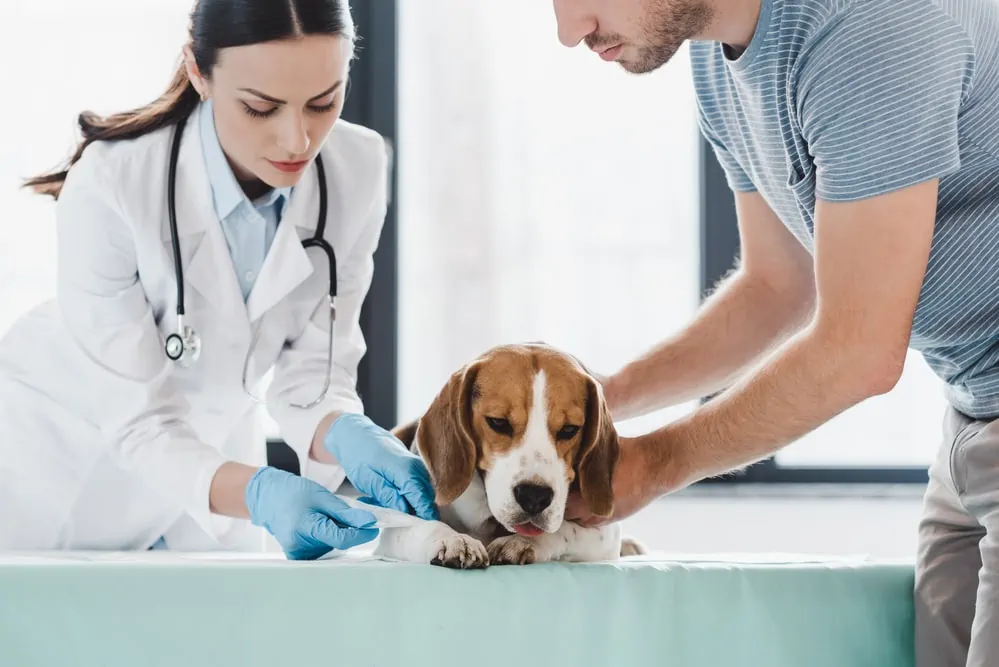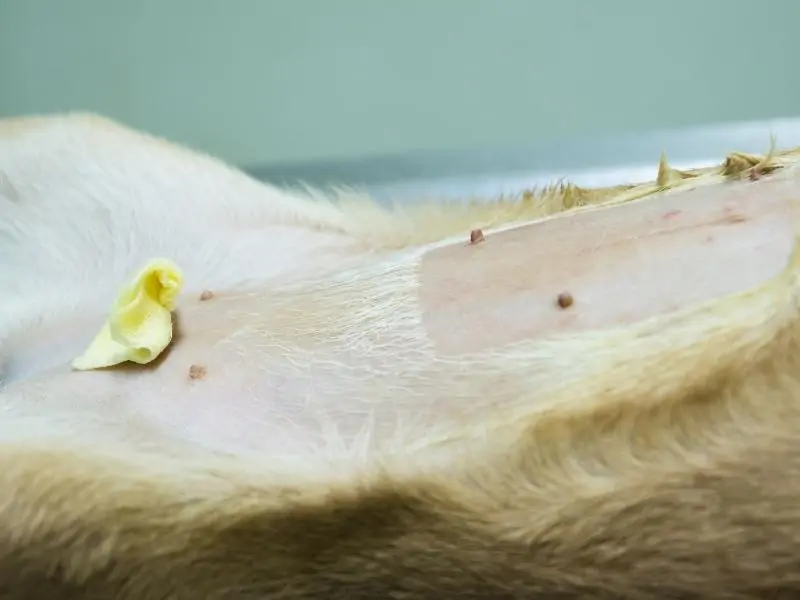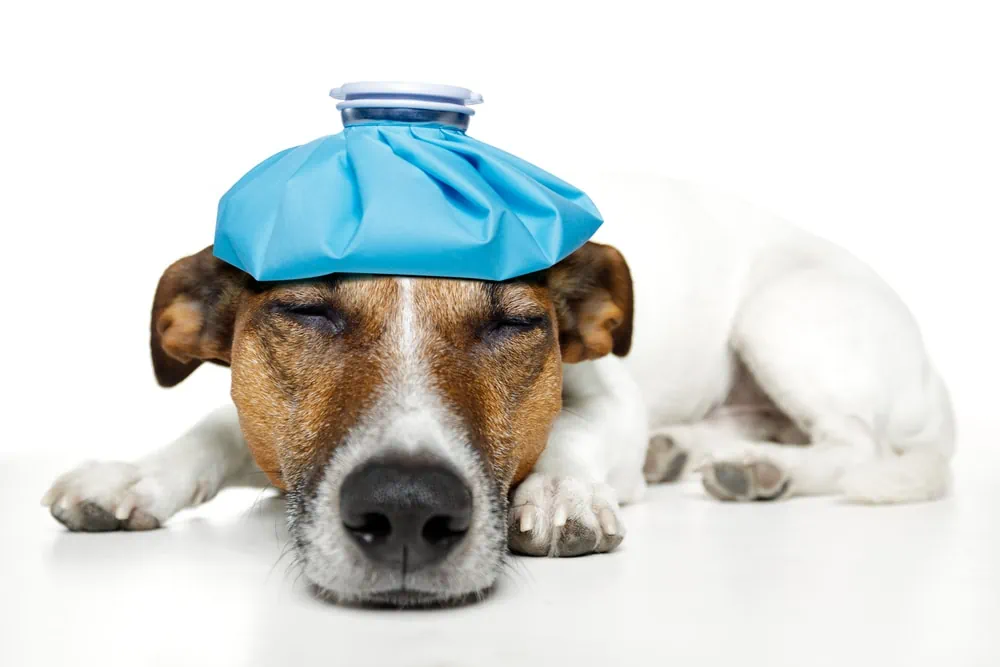It is common practice to spay female dogs, thereby removing their reproductive organs, particularly in first-world economies.
The main reasons for spaying include various health benefits and the reduction of unwanted puppies but there are also physical consequences associated with spaying.
One of these is the effect on dogs’ nipples.
All dogs have nipples, which extend from the groin area up to their stomachs.
Dogs generally have six to ten nipples, although this number can vary.
In female dogs, the mammary glands swell during heat or when they are lactating, causing the nipples to enlarge.
Do dogs’ nipples shrink after spaying?
Dog’s nipples do shrink after spaying and often return to their pre-pubescent state. This depends on the dog’s age and how many heat cycles the dog has experienced before spaying.
Each heat cycle stimulates hormonal changes that affect the mammary glands and mammary tissue also changes with age. Spaying will usually trigger shrinkage, but the extent will depend on these factors.
What is Spaying?

Spaying is specific to female dogs and refers to the removal of all or most of the animal’s reproductive organs.
The term “neutering” can also be used as it applies to the sterilization of both sexes.
In male dogs, the specific term is castration.
Spaying involves abdominal surgery to remove both the ovaries and uterus.
The medical term for this procedure is ovo-hysterectomy.
The operation is usually performed during open surgery as the alternative to doing laparoscopic surgery is more expensive.
Open surgery requires larger incisions and is, therefore, more painful and recovery is not as fast.
In open surgery, a midline incision would be made along the anesthetized animal’s belly and the ovaries and uterus removed.
Once bleeding is controlled, the wound is stapled or stitched closed.
Laparoscopic surgery would involve cameras and instruments being inserted through small incisions and the surgeon watches on a screen while performing the surgery.
Hormonal effects of spaying
Female dogs no longer produce progesterone after spaying.
Progesterone is a calming hormone that increases serotonin levels.
As a result of removing this hormone, some dog owners observe an increase in aggression after spaying (source).
Advantages of spaying
Spayed females generally live longer
Spaying reduces the risk of mammary cancer and pyometra (an infection of the womb), both of which can be fatal diseases.
This is especially true the earlier spaying is performed.
Females won’t go into heat
A female dog’s heat cycle can be messy and inconvenient for dog owners.
A female dog will experience her first season around six months of age and it usually lasts somewhere between ten days to two weeks.
While in heat, dogs will have a bloody vaginal discharge and they can howl and urinate frequently.
Pregnancy and birth can be risky for dogs
Certain breeds are at risk for pregnancy complications, particularly eclampsia in smaller dogs.
The cost of caring for a litter is significantly more than the cost of spaying your pet
Taking medical bills into account, having a litter of puppies can be very costly and even more so if there are any complications.
Neutering a pet is a relatively low cost.
Spaying your pet reduces the risk of unwanted puppies
Unwanted puppies are already a problem in many communities.
Risks associated with spaying

There is some evidence of urinary issues
Research has shown that some dogs carry a higher risk of urinary incontinence and urinary tract infections after spaying.
Some dogs with existing aggression become more aggressive
It is thought that the reduction of estrogen after spaying could cause dogs that are already aggressive to become more so.
Estrogen has calming, anti-anxiety effects.
The surgery itself has a risk of complications
All surgery carries some risks and there is always the possibility of bleeding or infection following spay surgery.
Risk of developing hip dysplasia
Studies have shown that dogs that are spayed very early (before the onset of puberty) are more likely to develop hip dysplasia.
This is thought to be because spaying stops the production of sex hormones which are active in the closure of bone growth plates while the dog is still growing.
Some pets are more likely to gain weight.
A neutered dog will have a lower metabolic rate and therefore require fewer calories.
If a dog’s diet is not adjusted after spaying, she will be more likely to gain weight.
Neutered dogs are more likely to develop alopecia (hair loss).
Some studies have shown alopecia to be more common following spaying, possibly as a result of fluctuating hormone levels.
Alternatives to spaying
Although the vast majority of pet owners opt for the procedure described above, there are various alternatives available.
Surgical alternatives (source)
Hysterectomy
The uterus and part of the fallopian tubes are removed during surgery, leaving the ovaries intact.
This means the dog will not be able to fall pregnant but will continue producing hormones.
Ovariectomy
Just the ovaries are removed, leaving the uterus intact.
This makes the dog unable to reproduce and also removes any hormone-related behavior.
Non-surgical options
There are new products that can be injected into the testes of male animals to stop sperm production.
At present, there are no non-surgical options for female dogs but research is underway.
Learn the pros and cons of neutering your dogs in this video here:
Issues Impacting Dog Nipples

Pregnancy and Heat
During each heat cycle, hormonal changes affect a dog’s mammary glands, causing them to swell.
Over time this creates changes in the tissue and the nipples become permanently enlarged.
Nipples will also be swollen during pregnancy and when a dog is lactating to enable puppies to feed.
Breast tumors in dogs
Mammary tumors are relatively common in dogs, with risks higher for female dogs that are intact (haven’t been spayed) and those that were spayed later in life.
This is because the hormones that trigger swelling in the nipples during pregnancy or heat can cause abnormal growth which leads to cancer.
Spaying greatly reduces the risk of mammary cancer in dogs.
The incidence of mammary tumors in un-spayed female dogs is 71% (of which half will be malignant).
If a dog is spayed before its first heat cycle, this risk declines to 0.35%, which is almost negligible.
The positive effect of spaying decreases with each heat cycle that a female dog experiences.
Mammary tumors are usually observed as a mass beneath the skin on the abdomen.
Sometimes there may be discharged from a mammary gland, painful nipples or ulcers on the skin over the gland.
A veterinarian will then perform a physical examination as well as some of the following procedures to determine the stage of cancer:
- Bloodwork
- Ultrasound, x-rays or CT scan (to check for cancer in other parts of the body)
- Aspiration (sample taken from the mammary mass for testing)
- Biopsy (to test for other types of tumors)
Most mammary tumors need to be surgically removed and chemotherapy may be required following surgery.
Certain breeds of dogs are at higher risk than others, with poodles, dachshunds, and spaniels being most affected (source).
Mastitis
Mastitis is a bacterial infection that can affect dog nipples and can be life-threatening if not treated adequately.
It is most often seen in dogs that are lactating or dogs that have a pseudo-pregnancy (mammary glands swell as if she is pregnant and she behaves as if pregnant).
Although rare, mastitis can also affect spayed dogs and even male dogs.
Mastitis is generally caused by poor hygiene, the trauma inflicted by puppies or systemic infection.
Dogs with mastitis will have swollen mammary glands that may be leaking pus.
They are also likely to be lethargic and disinterested in eating.
If the dog has puppies, she may not be feeding them.
Mastitis must be treated immediately by a veterinarian because it can lead to septic shock, which can be fatal.
It is generally treated with antibiotics and warm compresses to soothe the affected nipples.
In extreme cases, the mammary gland may have to be removed during surgery.
Aesthetics
Many pet owners don’t like the look of saggy nipples.
After numerous heat cycles and pregnancies, the nipples swell and don’t return to their original state.
Overbreeding, when owners allow to many litters to make cash out of the puppies, often leads to large, sagging nipples.
Rescue organizations often struggle to rehome these dogs as they are less attractive to potential owners.
One shelter in the UK even went as far as performing cosmetic surgery on two dogs to reduce the size of their sagging mammary glands (source).
The dogs had spent months in the shelter but were rejected by people because of their appearance.
The surgery was a success and both dogs were happily rehomed.
Related Content: Should Dogs Eat More Than Once Per Day? How much food do they really need?
Final Thoughts
If the appearance of your dog’s nipples is an issue, evidence suggests that spaying your pet will not worsen them.
If anything, spaying can result in less enlarged nipples over time depending on how many litters the dog has previously had.
It is also medically safer to spay your pet and all arguments seem to point towards spaying as responsible pet-owner behavior unless you are a breeder with the time and resources to commit to raising a litter.


0 Comments